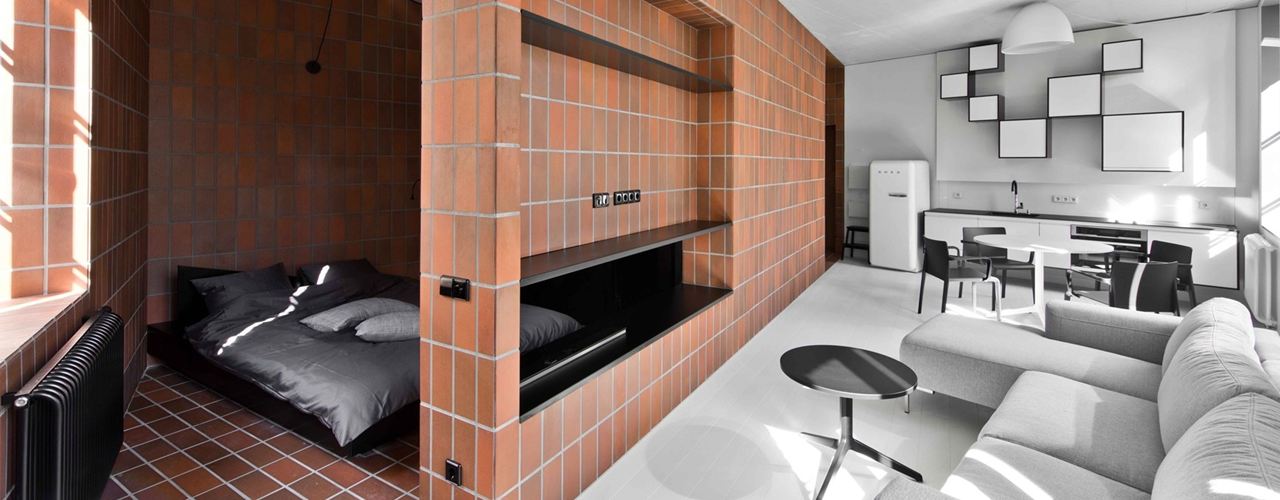Apartment 'Bazillion': day and night / openness and privacy / warm and cold
Striking contrasts skilfully staged
 The interior is designed by YCL Studio, an upcoming Vilnius-based office, led by the architects Tomas Umbrasas, Aidas Barzda, Tautvydas Vileikis and the graphic designer Rokas Kontvainis. They describe their company, which was founded in 2011, as an “architectural collaborative operating in the fields of architecture, interior design, planning, urban space and landscape design as well as research”.
The interior is designed by YCL Studio, an upcoming Vilnius-based office, led by the architects Tomas Umbrasas, Aidas Barzda, Tautvydas Vileikis and the graphic designer Rokas Kontvainis. They describe their company, which was founded in 2011, as an “architectural collaborative operating in the fields of architecture, interior design, planning, urban space and landscape design as well as research”.
They position themselves as “part of the new generation of Lithuanian architects using their international experience to enrich and strengthen the local architecture as well as to make it known internationally”. Aida Barzda considers the apartment “Bazillion” as the successful result of the work for an open-minded client and the co-operation with committed suppliers and building companies.
In the case of this apartment, the designers of YCL have made use of the available space and divided it with an intelligent solution: an oblique wall splits the interior into two parts of the same size, one containing the living area and the kitchen, the other the bedroom and the bathroom. The former is cool and light, the latter warm and massive. The cool part has a white wooden floor, a white ceiling and white walls, while the floor and the walls of the warm part are covered with ceramic tiles in three shades of an earthy red-brown colour. The tiles were chosen from the series Goldline of AGROB BUCHTAL. The concrete ceiling of this part of the apartment is painted in a terra-cotta colour corresponding with the tiles. The connecting element between the two contrasting parts of the interior is furniture in black, white and grey.
 The absence of any other colours has a strong effect and conveys the slightly unusual impression of being in a partially coloured black-and-white movie. A comparable monochromatic colour strategy has already been used by YCL in several other projects.
The absence of any other colours has a strong effect and conveys the slightly unusual impression of being in a partially coloured black-and-white movie. A comparable monochromatic colour strategy has already been used by YCL in several other projects.
In the process of designing the apartment’s interior, the architects explored numerous possibilities to maximize the difference between the two parts and tested diverse contrasts in material and colour. Barzda explains: “We imagined that the day is bright, full of light, talks, friends and meals, while the night asks for a private, safe and cosy place which is a bit dark and sleepy. This opposite is articulated by drawing a sharp line.” Expressing these different moods in a relatively contained space was the fundamental concept and had an influence on all design decisions. Barzda says that for them as architects and also for the client, who was fond of the idea, the apartment should have a strong and unconventional character.
The chosen contrast between white wood and archaic-powerful ceramics is not only strong in itself but contains an intriguing twist as well. The conventional division in apartments usually depends on the presence or absence of running water. Thus mostly the kitchen, the bathroom and the toilet are grouped together and often considered as a unit. In this case, however, tiles were not used for the “wet” part in the kitchen, but amazingly for the bedroom.
 According to Barzda, there were several reasons for deciding in favour of these tiles in this part: “We wanted to use a natural material which can “fill the space” and conveys a feeling of durability.” The colour is reminiscent of the red brick buildings of the Old Town of Vilnius. Moreover, the designers thought that this kind of ceramics would create the desired calm atmosphere. The most significant criterion, however, is how the tile has been liberated from its usual, limited role and has become a central element of the interior. In this way, the “Bazillion” apartment convincingly underlines the versatility of ceramic wall and floor coverings, which can be used creative to establish a large variety of different styles depending on the context.
According to Barzda, there were several reasons for deciding in favour of these tiles in this part: “We wanted to use a natural material which can “fill the space” and conveys a feeling of durability.” The colour is reminiscent of the red brick buildings of the Old Town of Vilnius. Moreover, the designers thought that this kind of ceramics would create the desired calm atmosphere. The most significant criterion, however, is how the tile has been liberated from its usual, limited role and has become a central element of the interior. In this way, the “Bazillion” apartment convincingly underlines the versatility of ceramic wall and floor coverings, which can be used creative to establish a large variety of different styles depending on the context.
AGROB BUCHTAL on Archiproducts.com



